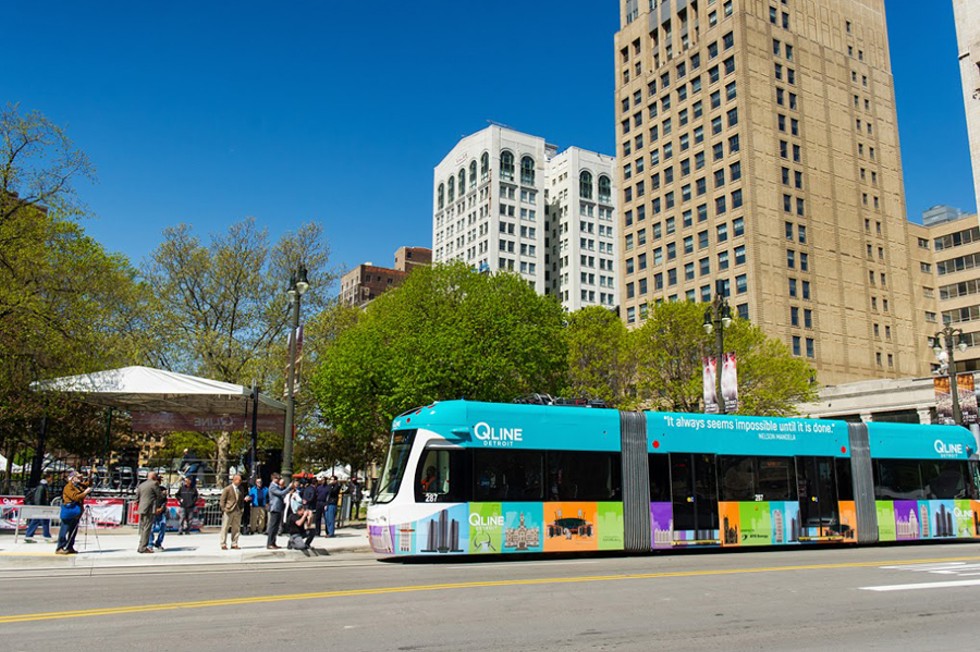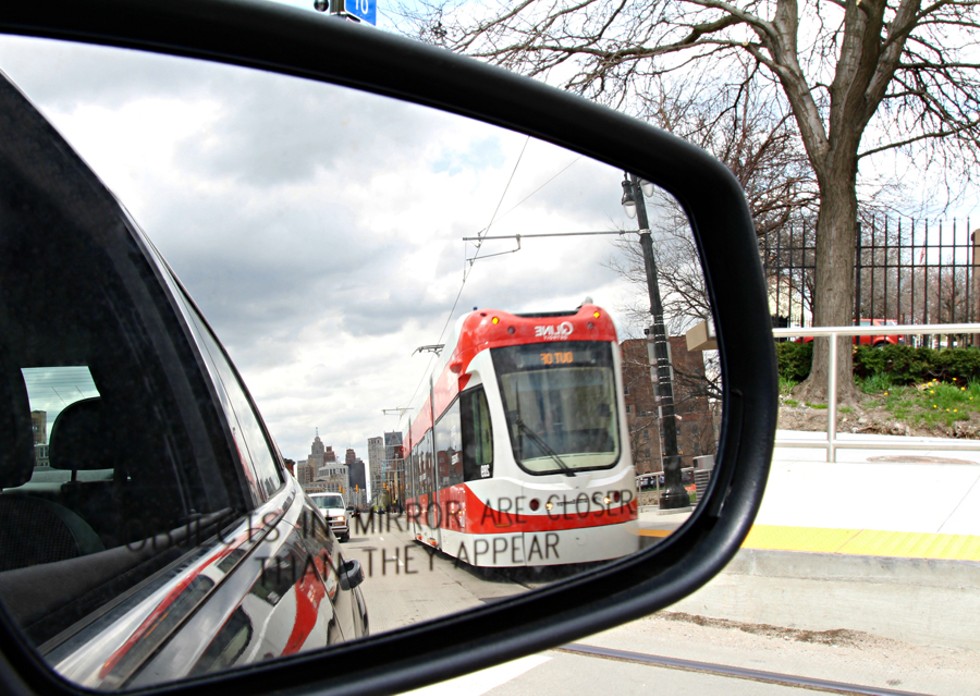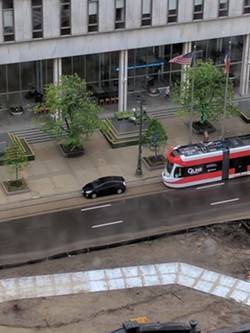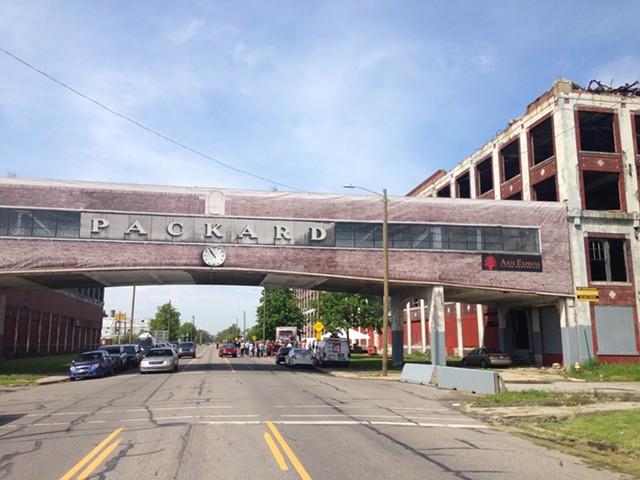When considering the QLine, Detroit's new $180 million streetcar that finally opened to the public last week after nearly a decade in development, compare the modest scope of the project to its larger-than-life rollout.
It is the first streetcar to roll down Woodward Avenue in 61 years. It transports riders on a roughly 25-minute, 3.3-mile trip from the New Center to the heart of downtown. At least initially, service ends at 11 p.m. on weekdays, midnight on Fridays and Saturdays, and 8 p.m. on Sundays.
The project made its public debut May 12 with all the pomp and circumstance of a World's Fair. To celebrate, the city threw a "QLine Detroit Festival" over the weekend, which kicked off with a ribbon-cutting and speeches from the project's backers, the M-1 Rail nonprofit, whose board of directors includes billionaires like auto magnate Roger Penske and Quicken Loans head honcho and downtown developer Dan Gilbert.
The QLine cars were assigned numbers starting at No. 287 — picking up after Detroit's last streetcar, No. 286, — an homage to the city's golden era. Retired WDIV anchor Carmen Harlan, arguably the voice of Detroit, was tapped to record the streetcar's automated messages. And just in time for the festivities, the red streetcars were decked out in a new teal wrap, featuring illustrations of Detroit's iconic buildings and inspirational quotes from the likes of Rosa Parks ("To bring about change, you must not be afraid to take the first step. We will fail when we fail to try."), Nelson Mandela ("It always seems impossible until it's done."), and Big Sean. ("You used to tell me the sky's the limit. Now the sky's our point of view.")
Given the celebratory atmosphere of the event, the quotes seemed less decorative and more an attempt at self-reflexivity regarding the project itself. In his speech, Gilbert oscillated between the hyperbolic and the grandiose, remarking on the cooperation necessary between the various political, state, federal, nonprofit, and for-profit entities to complete the project.
"Maybe we should get more than a light rail line out of this. Maybe we should get a Nobel Peace Prize, as I think about it," he joked.
Later, he heaped on more praise. "We think today makes a historic beginning," he said. "The QLine is not only going to be highly impactful along Woodward Avenue, but it's also the symbolic project that will represent the movement of our entire region's culture from one of separation, conflict, and turmoil to an environment of partnership, cooperation, and execution."
Grandiosity aside, the QLine is a new option for public transportation in a city and region that has infamously shunned it in favor of the automobile. And the M-1 Rail says it could be the start of a new system that will extend into the rest of the region.
Others, however, have doubts, and point to the People Mover — another little engine that could.
As the QLine's backers were delivering their speeches in Grand Circus Park, a group of bus rider advocates called the Motor City Freedom Riders gathered around the nearby statue of progressive Detroit mayor Hazen S. Pingree, holding signs calling for better transportation in the region.
Like the QLine, this group also referenced Rosa Parks, appropriating her mug shot as their logo, along with the tagline "transportation is freedom." One sign read "Stop transportation segregation."
The problem, members of the group say, is that the QLine does little to address the region's transportation woes. With or without the streetcar, Detroit still has one of the worst public transit systems in the nation, and according to a 2014 University of Michigan study, at least a quarter of Motor City households don't own a car.
"I think it's rather premature for politicians and corporate leaders to be celebrating a streetcar that simply duplicates existing bus service when the transit crisis in the region remains completely unresolved," says Joel Batterman, a coordinator for the group. He points out that during the past decade, massive cuts to the DDOT and SMART bus systems have resulted in a one-third reduction in services. Before the QLine, Woodward Avenue was already served by three bus lines.
Horror stories of delayed and scarce bus service are rampant, dramatically encapsulated in the Detroit Free Press' viral 2015 story of James Robertson, a middle-aged man whose daily 23-mile commute from Detroit to his factory job in Rochester Hills took at least four hours each way, through a gruelling combination of bus-hopping and walking for many miles.
Batterman, too, is familiar with the shortcomings of the region's bus system. He lives in Detroit, and is currently a Ph.D. student at the U-M's Taubman College of Architecture and Urban Planning. He says he and his wife share a car; otherwise, he gets around by bus and bicycle. Since there is no bus service between Detroit and Ann Arbor, he carpools to school.
It didn't have to be like this.
In November, metro Detroit came close to finally tackling its transportation issues with a Regional Transit Authority measure, which would have implemented a 20-year property tax millage across the four-county area to fund more bus services, including high-speed bus rapid transit routes.
The measure narrowly failed by just some 18,000 votes, hampered by Oakland County executive L. Brooks Patterson and Macomb County executive Mark Hackel, who refused to advocate for it.
That's why Batterman and the Motor City Freedom Riders say they used the launch of the QLine to call on government leaders to support a revised measure in 2018.
"The public demand is already there," he says. "The roadblock is not public opinion so much as the entrenched old guard political leadership of the region, particularly in the suburbs."
The RTA millage was the latest in a long series of failed attempts to bring robust public transportation to the city and region — dating back to a scrapped subway system from more than a century ago to an ambitious federally funded regional light rail system that was ultimately dropped under President Ronald Reagan.
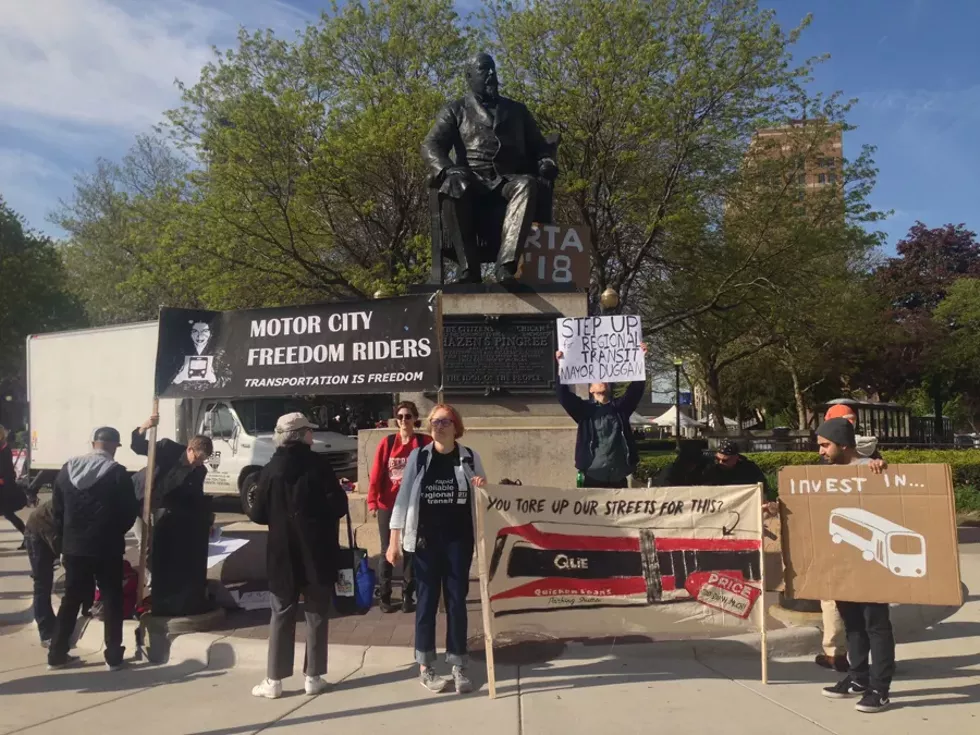
Downtown's elevated People Mover, which turns 30 this year, is a vestige of that grand plan. Originally intended to feed into lines that would travel to the suburbs, today the often-lonely automated train takes riders on a 2.9-mile loop downtown — largely considered to be useless, except perhaps for the influx of tourists during the North American International Auto Show.
It's easy to draw comparisons between the People Mover and the QLine. Not only do they run similar lengths, but like the People Mover, the QLine was originally intended to be part of a grander plan, too.
The last time what was then known as the M-1 Rail project appeared on the cover of Metro Times, that grand plan seemed within reach. In a Feb. 23, 2011, feature story, the project was described as the "latest hope for the real start of a system that would connect the discrete existing parts: the People Mover, Amtrak, and the city and suburban bus systems."
The project got its start amid the afterglow of Detroit hosting Super Bowl XL in 2006. The M-1 Rail was formed by private sector leaders in 2008, who initially proposed a 3-mile streetcar system along Woodward Avenue. As support grew, the city and state got involved, and the concept ballooned into $500 million 9-mile high-speed light rail system that would extend to Eight Mile.
Not only do they run similar lengths, but like the People Mover, the QLine was originally intended to be part of a grander plan, too.
tweet this
But there was uncertainty: While President Barack Obama's administration was friendly toward public transportation projects, there was the looming question as to whether whoever won the White House in 2012 would share that priority. And even at that slightly grander 9.3-mile scale, some were concerned the project wasn't enough of an investment.
"I just worry that we're not thinking big enough with this project," then-Detroit City Councilman Ken Cockrel said at the time. "You could raise the question: How is this not just the People Mover on steroids?"
By 2011, the 9.3-mile light rail was deemed unfeasible, and the project was scaled back down to the 3-mile streetcar. Even still, the project was awarded a $25 million federal grant under Obama. Construction commenced in 2014.
Despite essentially being a late-1800s technology, the electric streetcar is enjoying something of a renaissance in North America. It started with Portland's in 2002, which was at the time the first modern streetcar system in the United States since World War II. Similar systems flourished with the help of Obama-era federal funding, and now there are modern streetcar systems in cities like Atlanta, Cincinnati, Dallas, Kansas City, New Orleans, Salt Lake City, Tucson, and Washington D.C.
What has drawn investors to these projects isn't their efficiency — with their slower speeds and high costs to build, streetcars aren't the most efficient way of moving people around. But they do have a propensity for spurring development, with the runaway success of Portland's streetcar serving as a case study in how it can be done. While conventional urban planning called for "transit-oriented development," the streetcar revival flips the script, and boosters unironically use the phrase "development-oriented transit" to describe the projects. In other words, the focus is on the development, not the transit.
"I think the important point is that streetcars are not rapid transit, and they're not a regional transit technology," Batterman says. "They're intended for local circulation. Specifically, they've been constructed as a real estate development tool."
For developers, streetcars have a certain curbside appeal. Instead of separating the QLine in a high-speed dedicated median lane, M-1 Rail opted for slower tracks that occasionally run alongside the curb. The idea is such a design "activates" the sidewalk, encouraging people to spend their money at local businesses like coffee shops and stores while they wait for the streetcars.
According to M-1 Rail, development along the route has seen $7 billion in new investment spent or planned since 2013, when the project secured its $25 million federal grant (the number includes developments like the $1.2 billion District Detroit, which includes the Little Caesars Arena).
Batterman believes there are other factors at play. "As a friend of mine put it, 'White people prefer rails on their buses,'" he says bluntly. "I think there's an idea that the streetcar will draw white people, middle- and upper-class people, who might not be comfortable riding a DDOT bus to try riding public transit."
But if the QLine can be accused of putting limited development before the city's larger transportation needs, Batterman says that is less to do with a corporate hijacking (the "Q" in QLine is for Quicken Loans; Gilbert reportedly bought the naming rights in 2016 for $5 million) than it is to do with the lack of political leadership here.
"What we really have is a deficit of democracy in the region," he says. "I think in the vacuum of public leadership, the corporate leaders stepped in and, unfortunately, rather than compelling officials to act in the interest of the region, and rather than themselves financing something that could have potentially become a larger regional transit project, they chose a curb-running design that would advance their short-term interests more than those of the broader public."
And while cranes and construction crews have been an ubiquitous sight along the Midtown and downtown Woodward corridor for the past few years, not everyone has been sharing the economic boom. With QLine construction limiting Detroit's main thoroughfare for the better part of the past two years, many businesses have felt a pinch due to blocked parking.
When we interviewed Dan Tatarian of clothier Showtime in 2014, he complained about a steep drop in customers once QLine construction started. He had been in business since the late 1980s. Unable to weather the construction, Showtime closed in 2016.
Sharil Roby of Roby's Shoes echoes the sentiment.
"It was a disaster, the sidewalk was dug up, the street was dug up. Business was down 75 percent," she said. "Some days we made $50, if we were lucky. It was a nightmare."
Yet Roby's Shoes managed to survive. Roby says it was because they owned the building, which they moved into in 1979. Her neighbors who were leasing — a dollar store, a hardware store — went out of business.
But with construction completed, Roby is optimistic. She says she's already seen an influx of new customers.
"(The QLine) doesn't go real fast, so people riding on it can see the businesses that are around here," Roby says. She says most of the buildings around her have now been purchased, and new businesses are moving in.
"I'm happy that they did it," she says. "We did need some kind of transportation like that. But for the businesses here, I just wish when they were planning this they would have thought of the existing businesses and helped them out somehow financially so they all could exist."
Paul Childs, the M-1 Rail's chief operating officer, says he remembers riding Detroit's last streetcarsin his youth. Before the QLine opened to the public, the M-1 Rail invited members of the media for a preview and during our trip down Woodward Childs waxes nostalgic.
"My mother would take me to the doctor's on the Woodward streetcar up in Highland Park," he says. When asked to describe the ride, he says, "It was crowded and bumpy."
Childs explains the streetcars are operated by a driver, who uses levers to accelerate and brake. The cars are American-made, manufactured in Brookville, Pa., by Brookville Equipment Corporation, the leader of the modern American streetcars. The QLine, Childs says, is notable for being the largest off-wire system in North America.
As we depart the Penske Technical Center in the North End, Childs says the streetcar is running on battery. At a certain point, an arm called a pantograph is deployed by the driver, which catches an overhead wire to draw electricity, and the streetcars generate even more electricity by braking. They have no front and no rear; at the end of its trip, the operator simply gets out and walks to the seat on the other side to make the same trip in reverse.
When asked if the QLine could one day expand into a larger regional system, Childs says that depends on whether a new RTA referendum gets passed in the future. The M-1 Rail, he says, will do whatever it can to support such a measure.
With their slower speeds and high costs to build, streetcars aren’t the most efficient way of moving people around. But they do have a propensity for spurring development.
tweet this
"You have to step all the way back. This project wasn't necessarily for us to consider expansion," he says. "We knew it'd be catalytic. We wanted to demonstrate how multi-modes of transportation work. We knew the economic development would come with it."
He says the M-1 Rail hopes to eventually gift the system to the RTA or another transit agency, which would come with matching federal government funds of $60 million.
"We would love to see streetcars expand," he says. "Where it expands is up to the RTA and the rest of the community. It's not our call."
Currently, Childs says the QLine has secured funding to operate through 2022 — assuming it reaches its goals of 5,000 to 8,000 passengers per day. It's not far-fetched. According to DDOT, the Woodward Avenue Route 53 bus provides approximately 8,500 rides daily (although that accounts for the entire route, which runs farther north than the QLine, and also runs 24-7). The People Mover reports 5,500 daily riders, though that average is almost certain to be boosted by the North American International Auto Show. It is possible the QLine could see a similar surge with sporting events at the nearby Comerica Park and Little Caesars Arena.
Childs says it wasn't easy to secure the funding for the project — the funding came from an unprecedented partnership between the M-1 Rail nonprofit, business leaders, the Michigan Department of Transportation, and the city of Detroit.
"One of the things that happens is your ability to get funding as a private entity is very, very restricted. The way we were able to do it is by partnering with MDOT and partnering with the city of Detroit for the federal money. That's highly unusual," he says. "It was quite the maneuvering act, and it took cooperation at the state level, and the federal level, the county level, and the city level. It's an unprecedented arrangement in North America."
Also unprecedented: The M-1 Rail project, Childs says, involved infrastructure investments beyond the rail itself. "One of the most expensive things you do is dig the hole. Once the hole is dug, everyone goes, 'Can I jump in?'" he says. "So it's not just the philanthropic ... community doing M-1 Rail. It was the entire business community coming in to revitalize this corridor."
For example, construction included rebuilding Woodward Avenue's I-94 and I-75 bridges. DTE Energy installed 15,000 feet of new conduits under the road, internet provider Rocket Fiber added high-speed WiFi to the train and all of its stations, and the city replaced water mains that had not been upgraded since the 1800s.
"There were other entities that made investments in the corridor that you don't see today, but you will see in 30 years," Childs says. "And some of them you're benefiting from right now — you just don't know you're benefiting from them."
As we approach the city's theater district, the streetcar abruptly comes to a halt. It turns out a construction cone has somehow made it onto the track, and an attendant has to get out of the streetcar to move it out of the way. The interruption lasts only a few minutes.
So far the launch of the QLine hasn't been without its blemishes. A writer at Bridge magazine relayed a similar story on an early run. In that case, the streetcar's traffic signal malfunctioned, stalling the streetcar for 15 minutes.
And there are likely to be other bumps on the path ahead. For one, Detroiters and visitors will have to learn to share the road with the streetcar. Certain intersections have a signal for the QLine only, giving it the right of way while other traffic must stop. And the QLine's curbside tracks mean cars and delivery trucks can't park or stand on certain stretches of Woodward without holding up the streetcar. Signs have been installed warning drivers to stay clear of the tracks — or get slapped with a $650 ticket and a towed vehicle. During opening weekend, at least one car had to be towed for blocking the QLine.
To help educate drivers, M-1 Rail has created animated educational videos aimed to help drivers and bicyclists safely share the road. The videos are available on qlinedetroit.com and also on TV screens installed at the QLine stops.
The stops have another amenity — one that pays service toward the project's initial goals of eventually expanding into a regional transit system. Not only do the screens show when the next QLine train will arrive, they also show the location of nearby buses.
"It's like the beginning of a regional trip planner," explains M-1 Rail spokesman Dan Lijana. "We expect to be multi-modal, right? So let's get multi-modal."
Even as it stands, it's safe to say the QLine is already poised to be at least slightly more useful than the People Mover.
However, Batterman has doubts about whether the QLine could truly be the start of a new era of regional transportation in the region.
"I think, unfortunately, it's very unlikely that the streetcar will ever be extended northward, at least without completely reconstructing it so it is faster-running," Batterman says.
M-1 Rail has said that the existing QLine system wouldn't be modified to accommodate expansion. More than likely, it would act as a connector to other future systems — like, say, a separate bus rapid transit route on Woodward that extended from the North End to the suburbs.
In the meantime, Detroit has a shiny new streetcar — but one that Batterman says has come at the expense of the city's existing bus service. During QLine construction, the Woodward buses have been re-routed over to Cass Avenue at Martin Luther King Jr. Boulevard.
"For me, it's not a big deal to walk a few blocks over from the transit center," Batterman says. "But for a lot of people, particularly the elderly, that's a real inconvenience."
And Batterman points out it's the people who depend on the bus system — the elderly, low-income people, younger people — who are still waiting for the region to address their transportation needs.
"It's really something that holds back our entire metropolitan area," he says. "And unfortunately, the QLine does not address that crisis."
At the very least, the hype behind the streetcar could indicate that the region is getting on the right track when it comes to investing in public transportation — though there's still a long way to go.
Everything you need to know about riding the QLine
• The three-piece, articulated cars are 66 feet long and carry 125 passengers on average. They travel the maximum speed on Woodward — 35 m.p.h. — and stop for traffic lights.
• QLine streetcars are compliant with the Americans with Disabilities Act (ADA), allowing for station-level access for pedestrians.
• The cars are powered by a 750-volt lithium ion battery, operating 60 percent off-wire — the highest percentage of any streetcar system in the United States.
• The QLine will operate from 6 a.m. to 11 p.m. Monday through Thursday, 6 a.m. to midnight on Friday, 8 a.m. to midnight on Saturday, and from 8 a.m. to 8 p.m. on Sunday.
• There is no dedicated parking lot for the QLine. M-1 Rail recommends parking at the city’s various parking structures. A parking map is available at detroitmi.gov/parking.
• Walk-up fares are $1.50 for three hours. For seniors, the cost is 75 cents. A 24-hour fare is $3, monthly passes are $30, and annual passes are $285.
• Tickets can be purchased on the QLine Detroit iTunes mobile app or at qlinedetroit.com.
• Tickets can be purchased with cash on the streetcar. Credit cards can be used at stations or through an app that will be available. Another option is to pay at the Penske Tech Center, 7520 Woodward Ave.
• SMART and DDOT are accepting 25-cent transfers to and from the QLine.
• Due to popular demand, QLine rides are free for the remainder of the week.
• More information is available at qlinedetroit.com.

